The cuckoo family Cuculidae contains six subfamilies. The first three listed below are found in the New world, while the remaining three are found in the Old World.
* Coccyzinae – New World Cuckoos
* Neomorphinae – New World Ground Cuckoos
* Crotophaginae – Anis
* Cuculinae – Old World Cuckoos
* Phaenicophaeinae – Malkohas and Couas
* Centropodinae – Coucals
This article is about the Phaenicophaeinae subfamily which contains the couas, malkohas, and ground-cuckoos of Asia.
The members of this cuckoo subfamily are not brood parasites. That is, they lay their eggs in their own nests and raise their chicks. These nests are constructed in trees and bushes. The eggs are white. Except for Raffles’s malkoha, none of the other members of subfamily Phaenicophaeinae exhibit strong sexual dimorphism.
The couas are endemic to Madagascar. The blue coua, the crested coua, and the Verreaux's coua are arboreal while the remain 6 species are mainly terrestrial. All species have some bare blue orbital skin, the amount and intensity of the blue is species dependent. Depending on the species, they eat insects, small vertebrates, seeds, fruit.
Except for the blue malkoa and the red malkoha, which are found in Africa, these are all Asian birds. There are 7 malkoha genera as presented in this article. The main genus Phaenicophaeus contains at least 6 species. Some authorities present only 5 malkoha genera, placing the disenfranchised species in Phaenicophaeus. The malkohas tend to be arboreal, but many will also seek some prey on the ground. They eat mainly insects including caterpillars; also small vertebrates such as lizard, and fruits.
The cuckoo family Cuculidae
The cuckoo family Cuculidae is the only family of the order Cuculiformes. The family is represented on all continents except Antarctica. Most species reside in tropical or subtropical environments. Those in temperate locations migrate to avoid cool or cold winters. In addition to cuckoos, the family Cuculidae also includes the roadrunners, koels, malkohas, couas, coucals and anis. The coucals and anis are sometimes separated as distinct families. The cuckoos are generally medium sized slender birds. The majority are of the cuculidae family are arboreal, with a sizeable minority that is terrestrial.
Cuckoos are medium sized birds that range in size from 15-63 cm. There is generally little sexual dimorphism in size, but where it exists, it can be either the male or the female that is larger, depending on the genera. There are two basic body forms, arboreal species which are slender and terrestrial species which are more heavy set and have stronger legs. Almost all species have long tails which are used for steering in terrestrial species and as a rudder during flight in the arboreal species.
Many species are brood parasites, laying their eggs in the nests of other species, but the majority of species raise their own young. The brood parasitic birds usually only parasitize a single host species or a small group of closely related host species. They tend to remove a host egg when they lay one of their own in a nest. This both prevents the host species from realizing their nest has been parasitized and reduces food competition for the parasitic nestling once it hatches. Some brood parasites will eliminate all their nest-mates shortly after hatching. If the host removes a parasitic egg or chick, the adult parasitic birds may retaliate by destroying the nest.
There has been an evolutionary arms race between the cuckoos that leave their eggs in other nests, and the hosts that get these unwanted presents. The cuckoos have evolved to be able to lay their eggs faster than most other species and the eggs need less incubation time before hatching. These eggs often resemble the host eggs to prevent detection of an invader egg. The drongo-cuckoos resemble their host. Some hosts have evolve to be social so the colony can be on the lookout for an invader trying to deposit an egg. Others have more than one brood of chicks per year so there will be replacements for any losses due to cuckoos.
Cuckoos feed on insects, small animals, seeds, and fruit. For many cuckoo species, caterpillars are their favorite food; even hairy caterpillars that are avoided by most other birds. Cuckoos can consume hairy caterpillars because of their ability to shed their abdominal lining and get rid of the hairs via a pellet. Another favorite food of many cuckoos are grasshoppers. We may find it repugnant that some cuckooos are brood parasitic and they or their offspring even kill the host's chicks, but on the plus side cuckoos help prevent plagues of caterpillars and grasshoppers!
Almost all cuckoos are shy which can make them a challenge to observe and photograph. Consistent with this behavior, they are not colonial breeders. These traits may be have their roots in their brood parasitic behavior. Stealth is a good characteristic if you want to sneak an egg into a host's nest.
Genus Coua
These cuckoos are found on Madagascar. They have brightly colored bare skin around the eyes.
Coua,_Blue Coua caerulea

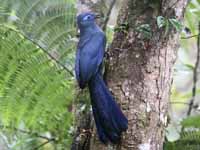
Coua,_Coquerel's Coua coquereli


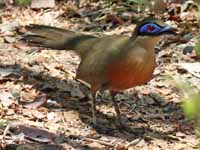
Coua,_Crested Coua cristata

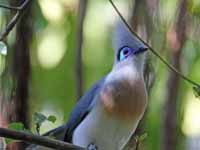

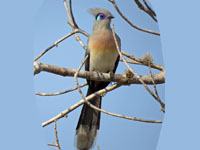
Coua,_Giant Coua gigas
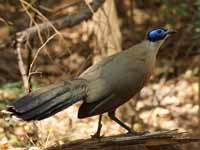
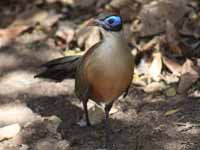
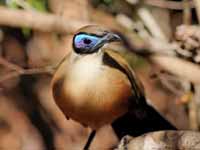
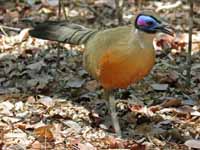
Coua,_Red-breasted Coua serriana
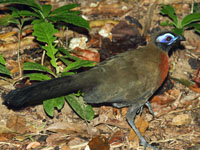
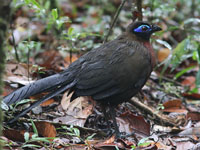
Coua,_Red-capped Coua ruficeps
1, 2, 3) Subspecies Green-capped Coua (Coua ruficeps olivaceiceps)
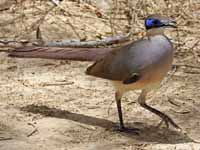
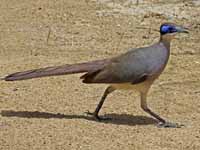
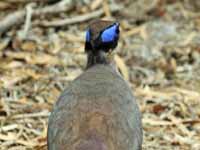
Coua,_Red-fronted Coua reynaudii

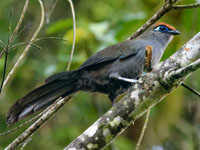
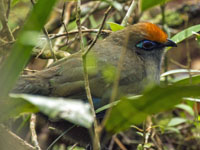
Coua,_Running Coua cursor
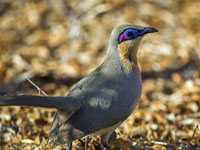


Coua,_Verreaux's Coua verreauxi
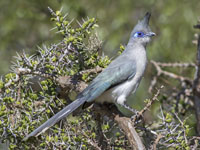
Genus Ceuthmochares
These two malkohas both have yellow bills. At one time they were treated as the same species and called the yellowbill. Both species are restricted to Africa. As members of the cuckoo family, they are zygodactyl (2 toes point forward, a 2 point to the rear). However, they are not brood parasitic, they build their own nests.
Malkoha,_Blue also Chattering Yellowbill Ceuthmochares aereus
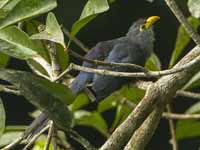


Malkoha,_Green also Whistling Yellowbill Ceuthmochares australis cumingi
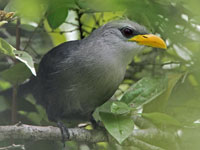

Genus Dasylophus
Instead of a separate genus, these two malkohas are sometimes place in Phaenicophaeus.
Malkoha,_Scale-feathered Phaenicophaeus cumingi also Dasylophus cumingi
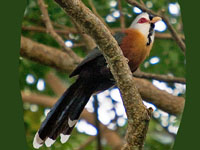
Malkoha,_Red-crested also Rough-crested Malkoha Phaenicophaeus superciliosus also Dasylophus superciliosus Found:
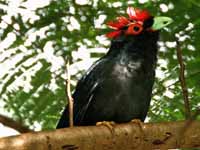
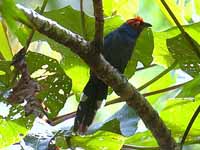
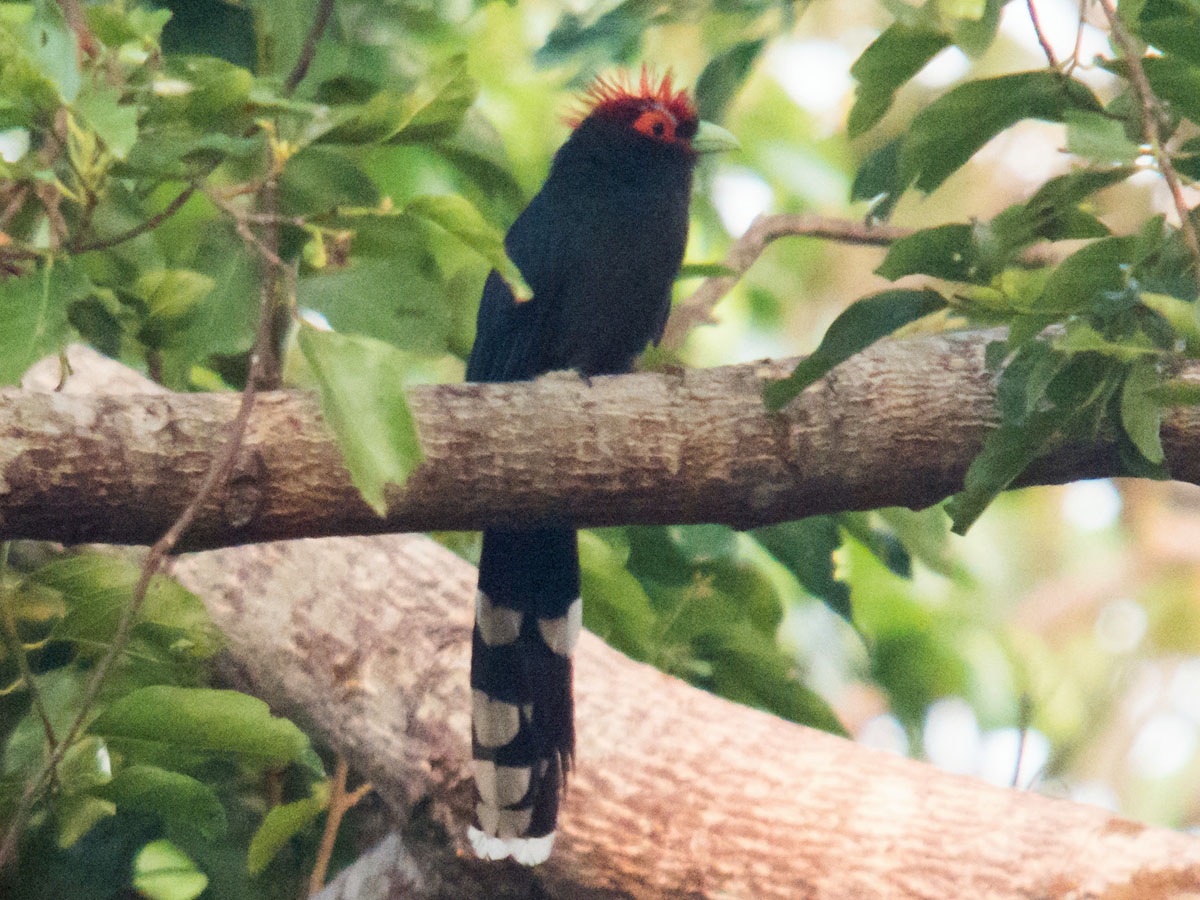
Genus Phaenicophaeus
These malkoha are all found in tropical Asia. The malkohas tend to be arboreal, but many will also seek some prey on the ground. They eat mainly insects including caterpillars; also small vertebrates such as lizard, and fruits. As members of the cuckoo family, malkoha are zygodactyl (2 toes point forward, a 2 point to the rear). However, they are not brood parasitic, they build their own nests.
Malkoha,_Black-bellied Phaenicophaeus
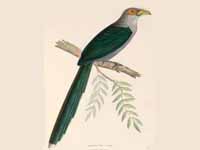

Malkoha,_Blue-faced Phaenicophaeus viridirostris Found: Indian subcontinent
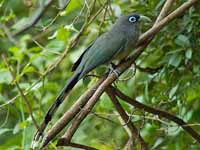

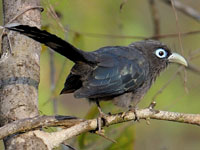
Malkoha,_Chestnut-bellied Phaenicophaeus sumatranus Found: Brunei, Indonesia, Malaysia, Myanmar, Singapore, Thailand


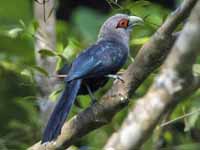
Malkoha,_Chestnut-breasted Phaenicophaeus curvirostris
1, 2) Female 3, 4) Male
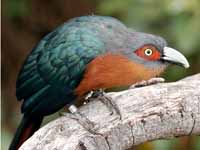

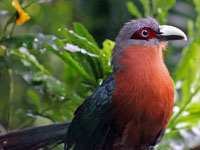
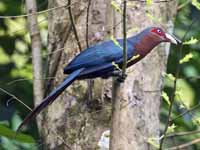
Malkoha,_Green-billed Phaenicophaeus tristis Found: south Asia, Indonesia, Malaysia

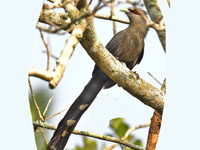
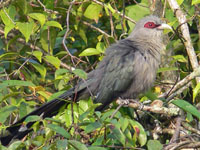
Malkoha,_Red-faced Phaenicophaeus pyrrhocephalus s
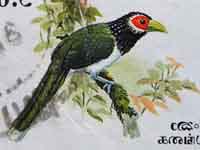

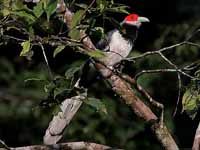
Genus Rhamphococcyx - 1 species
There is considerable disagreement whether the yellow-billed malkoha deserves its own genus as treated here, or if it should be in Phaenicophaeus.
Malkoha,_Yellow-billed Phaenicophaeus calyorhynchus also Rhamphococcyx calyorhynchus


Genus Rhinortha - 1 species
Malkoha,_Raffles's Rhinortha chlorophaea
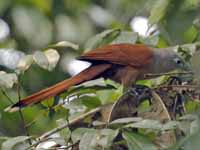
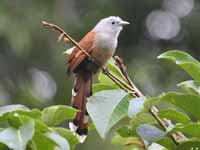
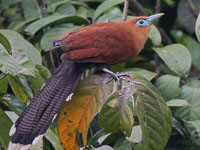
Genus Taccocua - 1 species
Malkoha,_Sirkeer Phaenicophaeus leschenaultii also Taccocua leschenaultii
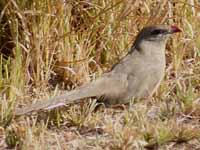
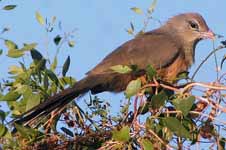
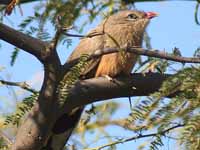
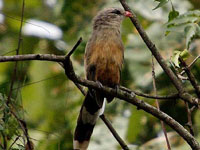
Genus Zanclostomus - 1 species
Malkoha,_Red-billed Phaenicophaeus javanicus also Zanclostomus javanicus Found: southeast Asia
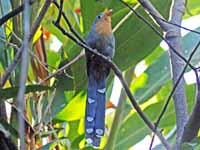
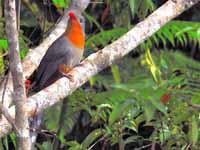

Genus Carpococcyx The Asian Ground-Cuckoos
These ground-cuckoos are terrestrial birds that live in humid Asian forests. The nest in trees. As is true for all members of subfamily Phaenicophaeinae, they are not brood parasitic.
Cuckoo,_Borneo Ground- Carpococcyx radiceus


Cuckoo,_Coral-billed Ground- Carpococcyx renauldi
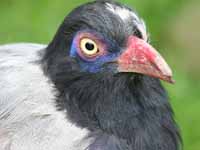
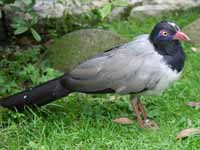
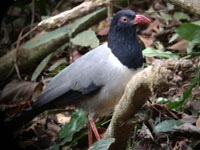
Cuckoo,_Sumatran_Ground- Carpococcyx viridis
* Coccyzinae – New World Cuckoos
* Neomorphinae – New World Ground Cuckoos
* Crotophaginae – Anis
* Cuculinae – Old World Cuckoos
* Phaenicophaeinae – Malkohas and Couas
* Centropodinae – Coucals
This article is about the Phaenicophaeinae subfamily which contains the couas, malkohas, and ground-cuckoos of Asia.
The members of this cuckoo subfamily are not brood parasites. That is, they lay their eggs in their own nests and raise their chicks. These nests are constructed in trees and bushes. The eggs are white. Except for Raffles’s malkoha, none of the other members of subfamily Phaenicophaeinae exhibit strong sexual dimorphism.
The couas are endemic to Madagascar. The blue coua, the crested coua, and the Verreaux's coua are arboreal while the remain 6 species are mainly terrestrial. All species have some bare blue orbital skin, the amount and intensity of the blue is species dependent. Depending on the species, they eat insects, small vertebrates, seeds, fruit.
Except for the blue malkoa and the red malkoha, which are found in Africa, these are all Asian birds. There are 7 malkoha genera as presented in this article. The main genus Phaenicophaeus contains at least 6 species. Some authorities present only 5 malkoha genera, placing the disenfranchised species in Phaenicophaeus. The malkohas tend to be arboreal, but many will also seek some prey on the ground. They eat mainly insects including caterpillars; also small vertebrates such as lizard, and fruits.
The cuckoo family Cuculidae
The cuckoo family Cuculidae is the only family of the order Cuculiformes. The family is represented on all continents except Antarctica. Most species reside in tropical or subtropical environments. Those in temperate locations migrate to avoid cool or cold winters. In addition to cuckoos, the family Cuculidae also includes the roadrunners, koels, malkohas, couas, coucals and anis. The coucals and anis are sometimes separated as distinct families. The cuckoos are generally medium sized slender birds. The majority are of the cuculidae family are arboreal, with a sizeable minority that is terrestrial.
Cuckoos are medium sized birds that range in size from 15-63 cm. There is generally little sexual dimorphism in size, but where it exists, it can be either the male or the female that is larger, depending on the genera. There are two basic body forms, arboreal species which are slender and terrestrial species which are more heavy set and have stronger legs. Almost all species have long tails which are used for steering in terrestrial species and as a rudder during flight in the arboreal species.
Many species are brood parasites, laying their eggs in the nests of other species, but the majority of species raise their own young. The brood parasitic birds usually only parasitize a single host species or a small group of closely related host species. They tend to remove a host egg when they lay one of their own in a nest. This both prevents the host species from realizing their nest has been parasitized and reduces food competition for the parasitic nestling once it hatches. Some brood parasites will eliminate all their nest-mates shortly after hatching. If the host removes a parasitic egg or chick, the adult parasitic birds may retaliate by destroying the nest.
There has been an evolutionary arms race between the cuckoos that leave their eggs in other nests, and the hosts that get these unwanted presents. The cuckoos have evolved to be able to lay their eggs faster than most other species and the eggs need less incubation time before hatching. These eggs often resemble the host eggs to prevent detection of an invader egg. The drongo-cuckoos resemble their host. Some hosts have evolve to be social so the colony can be on the lookout for an invader trying to deposit an egg. Others have more than one brood of chicks per year so there will be replacements for any losses due to cuckoos.
Cuckoos feed on insects, small animals, seeds, and fruit. For many cuckoo species, caterpillars are their favorite food; even hairy caterpillars that are avoided by most other birds. Cuckoos can consume hairy caterpillars because of their ability to shed their abdominal lining and get rid of the hairs via a pellet. Another favorite food of many cuckoos are grasshoppers. We may find it repugnant that some cuckooos are brood parasitic and they or their offspring even kill the host's chicks, but on the plus side cuckoos help prevent plagues of caterpillars and grasshoppers!
Almost all cuckoos are shy which can make them a challenge to observe and photograph. Consistent with this behavior, they are not colonial breeders. These traits may be have their roots in their brood parasitic behavior. Stealth is a good characteristic if you want to sneak an egg into a host's nest.
Cuckoo family members are zygodactyl: they have the 2 inner toes facing forward and 2 two outer toes facing to the rear.
Couas
Genus Coua
These cuckoos are found on Madagascar. They have brightly colored bare skin around the eyes.
Coua,_Blue Coua caerulea
Description: The Blue Coua has mainly blue plumage with blue skin around the eyes.x
Range: Madagascar - northwest and eastern areas
Habitat: Forests, not dry. Rarely found on the ground.
Diet: Insects including caterpillars, fruits, small reptiles.
Conservation status: Least concern.
Image by: 1) Olaf Riemer 2) Ross TsaiRange: Madagascar - northwest and eastern areas
Habitat: Forests, not dry. Rarely found on the ground.
Diet: Insects including caterpillars, fruits, small reptiles.
Conservation status: Least concern.


Coua,_Coquerel's Coua coquereli
Description: The Coquerel's coua has a blue patch around eye surrounded by black border. The upperparts are greyish-brown to brown, the bill is black and the legs are grey. There is a pale upper-breast and the rest of the underparts are reddish.
Range: Western Madagascar
Habitat: Dry deciduous forest where it stays mainly on the ground.
Diet: Insects, spiders, seeds.
Conservation status: Least concern.
Image by: 1) Ross Tsai 2, 3) Dick Daniels - Kirindy Forest, MadagascarRange: Western Madagascar
Habitat: Dry deciduous forest where it stays mainly on the ground.
Diet: Insects, spiders, seeds.
Conservation status: Least concern.



Coua,_Crested Coua cristata
Description: The crested coua has greenish-gray upperparts with a grey crest. The breast is reddish-orange blending to the white belly. It has brown eyes which are surrounded by blue bare orbital skin. The crested coua has a black bill and black legs.
Range: Madagascar. Most widespread of the coups.
Habitat: Mainly in trees.
Diet: Insects, fruits, berries, seeds, snails, and chameleons.
Similar to: Verreaux's coua. Verreaux's coua has darker crest than crested coua.
Conservation status: Least concern.
Image by: 1, 2) Dick Daniels - San Diego Zoo 3) Charles_J_Sharp 4) Pat and Keith Taylor - Mosa Spiny Forest Reserve Range: Madagascar. Most widespread of the coups.
Habitat: Mainly in trees.
Diet: Insects, fruits, berries, seeds, snails, and chameleons.
Similar to: Verreaux's coua. Verreaux's coua has darker crest than crested coua.
Conservation status: Least concern.




Coua,_Giant Coua gigas
Description: The Giant Coua has a blue patch around the eye surrounded by black border. It has olive-green upperparts and buff underparts; Coquerel's coua and the giant coua are similar. Coquerel's coua has a reddish belly while the Giant Coua belly has very little red.
Range: Southern and western Madagascar
Habitat: Dry forests.
Diet: Seeds, insects, small vertebrates.
Conservation status: Least concern.
Image by: 1) David Cook 2) J Fi 3) Daniel Guip 4) Dick Daniels - Kirindy Forest, MadagascarRange: Southern and western Madagascar
Habitat: Dry forests.
Diet: Seeds, insects, small vertebrates.
Conservation status: Least concern.




Coua,_Red-breasted Coua serriana
Description: The Red-breasted Coua has olive-green upperparts; dark red breast; There is a blue patch below eye, white above surrounded and the composite surrounded by black. Of all the coups it has the most white on its face.
Range: northeastern Madagascar.
Habitat: Rain forest. Found mainly on the ground, also in trees.
Diet: Fruit, seeds, insects.
Conservation status: Least concern.
Image by: 1) Nick Athanas 2) Amy_McAndrewsRange: northeastern Madagascar.
Habitat: Rain forest. Found mainly on the ground, also in trees.
Diet: Fruit, seeds, insects.
Conservation status: Least concern.


Coua,_Red-capped Coua ruficeps
Description: The red-capped coua has a red crown and a bright blue patch behind the eyes. It has gray / brown upperparts and pale underparts.
Range: Madagascar
Habitat: Dry forest. Found mainly on the ground. Similar to: Red-capped Coua. Red-capped coua has red on entire cap white the red-fronted coua has red on the front half of crown. Also, the blue around the red-capped coup is much more striking.
Conservation status: Least concern.
Image by: 1, 2, 3) Dick Daniels - Arboretum near Tulear, Madagascar. Range: Madagascar
Habitat: Dry forest. Found mainly on the ground. Similar to: Red-capped Coua. Red-capped coua has red on entire cap white the red-fronted coua has red on the front half of crown. Also, the blue around the red-capped coup is much more striking.
Conservation status: Least concern.
1, 2, 3) Subspecies Green-capped Coua (Coua ruficeps olivaceiceps)



Coua,_Red-fronted Coua reynaudii
Description: The red-fronted coua has red on its crown, brightest in the front. The eyes have some blue around them, a white tear drop at the rear, and a black outline. It has greenish-grey upperparts and lighter grey underparts.
Range: Eastern half of Madagascar
Habitat: Rain forest. Found mainly on the ground, but nests in trees.
Diet: Insects including caterpillars; also seeds and fruit. Similar to: Red-capped Coua. Red-capped coua has red on entire cap white the red-fronted coua has red on the front half of crown. Also, the blue around the red-capped coup is much more striking.
Conservation status: Least concern.
Image by: 1) David Cook 2) Allan_Hopkins 3) Francesco_VeronesiRange: Eastern half of Madagascar
Habitat: Rain forest. Found mainly on the ground, but nests in trees.
Diet: Insects including caterpillars; also seeds and fruit. Similar to: Red-capped Coua. Red-capped coua has red on entire cap white the red-fronted coua has red on the front half of crown. Also, the blue around the red-capped coup is much more striking.
Conservation status: Least concern.



Coua,_Running Coua cursor
Description: The running cola has bare blue skin around the eyes and that blue has a black outline. It has grey-green upper parts including the head and nape. The throat is yellowish-brown, the breast and upper-belly are grayish-purple, and the lower-belly is white. The bill and legs are black.
Range: southwestern Madagascar.
Habitat: Dry areas with little ground cover so it can easily walk/run.
Diet: Insects.
Conservation status: Least concern.
Image by: 1) Francesco Veronesi 2, 3) Alan_HarperRange: southwestern Madagascar.
Habitat: Dry areas with little ground cover so it can easily walk/run.
Diet: Insects.
Conservation status: Least concern.



Coua,_Verreaux's Coua verreauxi
Description: The Verreaux's coua has gray upperparts and a dark gray crest. The eyes are brown with blue bare orbital skin; the bill is black. The underparts are mainly white except light grey on the throat,
Range: southwestern tip of Madagascar
Habitat: The spiny forest zone where there is low rainfall and some spiny scrub related to cacti. They forage in the trees.
Diet: Invertebrates, fruit. Similar to: Crested coua. Verreaux's coua has darker crest than the crested coua.
Conservation status: Least concern.
Image by: 1) Zak_PohlenRange: southwestern tip of Madagascar
Habitat: The spiny forest zone where there is low rainfall and some spiny scrub related to cacti. They forage in the trees.
Diet: Invertebrates, fruit. Similar to: Crested coua. Verreaux's coua has darker crest than the crested coua.
Conservation status: Least concern.

Malkoas
Genus Ceuthmochares
These two malkohas both have yellow bills. At one time they were treated as the same species and called the yellowbill. Both species are restricted to Africa. As members of the cuckoo family, they are zygodactyl (2 toes point forward, a 2 point to the rear). However, they are not brood parasitic, they build their own nests.
Malkoha,_Blue also Chattering Yellowbill Ceuthmochares aereus
Description: The blue malkoha, also know as the chattering yellowbill, has grayish head, belly, and throat. It has a heavy yellow bill. Depending on subspecies, the blue malkoha has green or green and blue or blue back, wings, tail.
Range: Africa.
Habitat: Tropical rainforest.
Diet: Insects, frogs, slugs, fruit, seeds.
Conservation status: Least concern.v
Image by: 1, 2, 3) Francesco Veronesi - Ghana Range: Africa.
Habitat: Tropical rainforest.
Diet: Insects, frogs, slugs, fruit, seeds.
Conservation status: Least concern.v



Malkoha,_Green also Whistling Yellowbill Ceuthmochares australis cumingi
Description: The green malkoha, also known as the whistling yellowbill, has green upperparts; yellow bill..
Range: African east coast.
Habitat: Forest, usually found in the sub-canopy.
Diet: Insects, frogs, slugs, fruit, seeds.
Conservation status: Least concern
Image by: 1) Steve_Garvie 2) Jim Scarff - South AfricaRange: African east coast.
Habitat: Forest, usually found in the sub-canopy.
Diet: Insects, frogs, slugs, fruit, seeds.
Conservation status: Least concern


Genus Dasylophus
Instead of a separate genus, these two malkohas are sometimes place in Phaenicophaeus.
Malkoha,_Scale-feathered Phaenicophaeus cumingi also Dasylophus cumingi
Description: The scale-feathered malkoha has a grey head and white throat. There is a ribbon of black scale-like feathers from the bottom of the nape, across the head, to the bottom of the throat. It has dark brown upperparts and chestnut breast. The belly and wings are dark while the tail is black with white tips.
Range: Philippines.
Habitat: Mainly in tree; also in undergrowth.
Diet: Insects including caterpillars, snakes, lizards.
Conservation status: Least concern
Image by:
1) Lius LimchiuRange: Philippines.
Habitat: Mainly in tree; also in undergrowth.
Diet: Insects including caterpillars, snakes, lizards.
Conservation status: Least concern

Malkoha,_Red-crested also Rough-crested Malkoha Phaenicophaeus superciliosus also Dasylophus superciliosus Found:
Description: The red-crested malkoha, also known as the rough-crested malkoha, has a spiked red-crest and red skin around the eyes. The rest of the plumage is black except for white tips on the tail feathers.
Range: Luzon island in the Philippines.
Habitat: Mainly forest; also bushes.
Diet: Insects including caterpillars.
Conservation status: Least concern
Image by:
1) Blake Matheson 2) Francesco Veronesi 3) Eric_GroppRange: Luzon island in the Philippines.
Habitat: Mainly forest; also bushes.
Diet: Insects including caterpillars.
Conservation status: Least concern



Genus Phaenicophaeus
These malkoha are all found in tropical Asia. The malkohas tend to be arboreal, but many will also seek some prey on the ground. They eat mainly insects including caterpillars; also small vertebrates such as lizard, and fruits. As members of the cuckoo family, malkoha are zygodactyl (2 toes point forward, a 2 point to the rear). However, they are not brood parasitic, they build their own nests.
Malkoha,_Black-bellied Phaenicophaeus
Description: The black-bellied malkoha has grey upper parts with bluish-green wings. The breast is grey and the belly darker. It has bare red skin around the eye.
Range: Southeast Asia.
Habitat: Subtropical or tropical moist lowland forests and mangroves.
Diet: Insects including caterpillars.
Conservation status: It is near treated due to habitat loss. Images captions with links to large photos
Image by:
1) Marc 2) Peter_StewardRange: Southeast Asia.
Habitat: Subtropical or tropical moist lowland forests and mangroves.
Diet: Insects including caterpillars.
Conservation status: It is near treated due to habitat loss. Images captions with links to large photos


Malkoha,_Blue-faced Phaenicophaeus viridirostris Found: Indian subcontinent
Description: The blue-faced malkoha has a pale blue eye-ring. The throat has thin pale streaks and has a spiked appearance. The blue-faced malkoha has dark green upperparts and a large green bill. The upper-tail is dark edged with white and white tip. The under-tail is lighter with large white patches.
Range: India, Sri Lanka.
Habitat: A range of environments: semi-evergreen, deciduous forests, crub forest. In Sri Lanka it is restricted to the plains
Diet: Insects including caterpillars, small vertebrates, fruit. Forages in trees. Wiki says forages in undergrowth.
Conservation status: Least concern.
Image by: 1) Osado - India 2) Lip Kee - Sri Lanka 3) Kishore_BhargavaRange: India, Sri Lanka.
Habitat: A range of environments: semi-evergreen, deciduous forests, crub forest. In Sri Lanka it is restricted to the plains
Diet: Insects including caterpillars, small vertebrates, fruit. Forages in trees. Wiki says forages in undergrowth.
Conservation status: Least concern.



Malkoha,_Chestnut-bellied Phaenicophaeus sumatranus Found: Brunei, Indonesia, Malaysia, Myanmar, Singapore, Thailand
Description: The chestnut-bellied malkoha has a large patch of bright red skin around the eye. As one would expect because of its name, it has a chestnut colored belly. The rest of the underparts are grey as is the head. The upperparts are green.
Range: Southeast Asia
Habitat: Subtropical or tropical lowland forest, mangroves, or swampland
Diet: Insects including caterpillars.
Conservation status: The chestnut-bellied malkoha is near threatened because of habitat loss due to deforestation.
Image by: 1, 2, 3) Lip Kee - SingaporeRange: Southeast Asia
Habitat: Subtropical or tropical lowland forest, mangroves, or swampland
Diet: Insects including caterpillars.
Conservation status: The chestnut-bellied malkoha is near threatened because of habitat loss due to deforestation.



Malkoha,_Chestnut-breasted Phaenicophaeus curvirostris
Description: The chestnut-breasted malkoha has bright red skin around the eye. It has has gray and dark green upperparts, The crown and nape are black; the underparts are chestnut. The large and curved upper mandible is pale while the smaller and straight lower mandible is black. Females have yellow iris and males have blue.
Range: Myanmar, Thailand, Indonesia, Malaysia, Philippines.
Habitat: Subtropical or tropical moist lowland forests including mangroves.
Diet: Lizards, frogs, insects, baby birds; also crustaceans.
Conservation status: Least concern.
Image by: 1) Evan Parker 2) Dick Daniels - Bronx Zoo 3) cuatrok77 4) Lip Kee - MalaysiaRange: Myanmar, Thailand, Indonesia, Malaysia, Philippines.
Habitat: Subtropical or tropical moist lowland forests including mangroves.
Diet: Lizards, frogs, insects, baby birds; also crustaceans.
Conservation status: Least concern.
1, 2) Female 3, 4) Male




Malkoha,_Green-billed Phaenicophaeus tristis Found: south Asia, Indonesia, Malaysia
Description: The green-billed malkoa has a pale green bill and bare red skin around the eye with a white border. It has dark grey with green gloss upperparts with green wings. The long green tail is white tipped.
Range: Indian Subcontinent and Southeast Asia.
Habitat: Forests, bamboo, plantations, etc. Not restricted to a particular habitat.
Diet: Insects including caterpillars; also lizards.
Conservation status: Least concern
Image by:
1) Lip Kee - India 2) Tarak Kahn 3) DiyanRange: Indian Subcontinent and Southeast Asia.
Habitat: Forests, bamboo, plantations, etc. Not restricted to a particular habitat.
Diet: Insects including caterpillars; also lizards.
Conservation status: Least concern



Malkoha,_Red-faced Phaenicophaeus pyrrhocephalus s
Description: The Red-faced Malkoha has dark green upperparts and a red face. The chin is a mixture of black and white. The crown, throat, and upper-breast are black. The lower-breast and belly are white. There is pale.green bill. and the dark grey tail has white edges.
Range: Sri Lanka.
Habitat: Lives in dense forest and forages and nests in trees.
Diet: Insects including caterpillars, small vertebrates such as lizard, fruits.
Conservation status: The red-face malkoha is vulnerable dues to human disruption of its habitat. It mainly dwells in the canopy therefore logging can be devastating to it.
Image by: 1) P Khoo 2) Amila Salgado 3) Steve Garvie Range: Sri Lanka.
Habitat: Lives in dense forest and forages and nests in trees.
Diet: Insects including caterpillars, small vertebrates such as lizard, fruits.
Conservation status: The red-face malkoha is vulnerable dues to human disruption of its habitat. It mainly dwells in the canopy therefore logging can be devastating to it.



Genus Rhamphococcyx - 1 species
There is considerable disagreement whether the yellow-billed malkoha deserves its own genus as treated here, or if it should be in Phaenicophaeus.
Malkoha,_Yellow-billed Phaenicophaeus calyorhynchus also Rhamphococcyx calyorhynchus
Description: The yellow-tiled malkoha has a bright yellow bill and grey head. It has reddish-brown upperparts with dark purple wings. The throat and beast are rufous. The tail is black.
Range: Sulawesi, Indonesia.
Habitat: Mainly forest. Forages in the canopy.
Diet: Insects including caterpillars.
Conservation status: Least concern
Image by:
1) Arie Frahman - North Sulawesi 2) Francesco Veronesi - Tangkoko Sulawesi Range: Sulawesi, Indonesia.
Habitat: Mainly forest. Forages in the canopy.
Diet: Insects including caterpillars.
Conservation status: Least concern


Genus Rhinortha - 1 species
Malkoha,_Raffles's Rhinortha chlorophaea
Description: The male raffles’s malkoha has rufous upperparts, head. throat, and breast. It has a black tail with grey bars and a white tip. The belly is dark grey. The female raffles’s malkoha has a light grey head and mantle. She has a rufous back, wings, and tail with a white tip.
Range: Southeast Asia (Brunei, Indonesia, Malaysia, Myanmar, Singapore, Thailand).
Habitat: Various places such as forest, forest edge, scrub, swamps, plantations. Feeds in trees mainly, also on the ground..
Diet: Insects including caterpillars, spiders.
Conservation status: Least concern
Image by: 1) Lip Kee - Malaysia 2) Mark Benedict - Malaysia 3) Hiyashi_Haka - MalaysiaRange: Southeast Asia (Brunei, Indonesia, Malaysia, Myanmar, Singapore, Thailand).
Habitat: Various places such as forest, forest edge, scrub, swamps, plantations. Feeds in trees mainly, also on the ground..
Diet: Insects including caterpillars, spiders.
Conservation status: Least concern



Genus Taccocua - 1 species
Malkoha,_Sirkeer Phaenicophaeus leschenaultii also Taccocua leschenaultii
Description: The sirkeer malkoha, also known as the sicker cuckoo, has mainly earthy-brown plumage with some rufous on the underparts. The reddish brown eye is bordered above and below by a thin white edge. The hocked red bill has a yellow tip. It ha a long tail that may be edged with white. Juveniles are duller and barred above.
Range: Indian Subcontinent, Bangladesh, Sri Lanka. Also Pakistan.
Habitat: Dry forests, scrub land.
Diet: Insects including carepillars, lizards, fruit. Forages mostly on the ground.
Conservation status: Least concern
Image by: 1, 3) JM Garg - India 2) Jugal Tiwari - India 4) Mohan_KemparajuRange: Indian Subcontinent, Bangladesh, Sri Lanka. Also Pakistan.
Habitat: Dry forests, scrub land.
Diet: Insects including carepillars, lizards, fruit. Forages mostly on the ground.
Conservation status: Least concern




Genus Zanclostomus - 1 species
Malkoha,_Red-billed Phaenicophaeus javanicus also Zanclostomus javanicus Found: southeast Asia
Description: The red-billed malkoha has mainly gray plumage. It has a red bill, chin, and throat. Around the eye there is pale grey bare skin. The tail feathers are white tipped.
Range: Southeast Asia.
Habitat: Tree, scrubs, plantation.
Diet: Insects including caterpillars, spiders, crustaceans.
Conservation status: Least concern
Image by: 1 ) Dick Daniels - San Diego Zoo 2) Johnny Wee 3) Lip_kee - MalaysiaRange: Southeast Asia.
Habitat: Tree, scrubs, plantation.
Diet: Insects including caterpillars, spiders, crustaceans.
Conservation status: Least concern



Genus Carpococcyx The Asian Ground-Cuckoos
These ground-cuckoos are terrestrial birds that live in humid Asian forests. The nest in trees. As is true for all members of subfamily Phaenicophaeinae, they are not brood parasitic.
Cuckoo,_Borneo Ground- Carpococcyx radiceus
Description: The Bornean ground-cuckoo has mostly green upperparts. The head and neck are black except for green skin around the eye. The underparts have black and white barring.
Range: Borneo.
Habitat: Forests. Roosts and nests in trees,; forages on the ground (as implied by is name)..
Diet: Mainly insects; also fruit.
Conservation status: The Bornean ground-cuckoo is near threatened due to deforestation.
Image by: 1) Nicholas LeJeune 2) Mark_Louis_BenedictRange: Borneo.
Habitat: Forests. Roosts and nests in trees,; forages on the ground (as implied by is name)..
Diet: Mainly insects; also fruit.
Conservation status: The Bornean ground-cuckoo is near threatened due to deforestation.


Cuckoo,_Coral-billed Ground- Carpococcyx renauldi
Description: The coral-billed ground-cuckoo has a red bill which separates it from other members of this genus. The feet are also red. It has grey upperparts. The head, neck, and tail are black. The underparts are whitish with fine black vermiculation. There is bare skin around the eyes which is mainly blue with some red at the top.
Range: Cambodia, Laos, Thailand, Vietnam .
Habitat: Moist tropical lowland forests.
Diet: Insects; also small reptiles, birds, and mammals..
Conservation status: The coral-billed ground-cuckoo is vulnerable due to capture for food or bird trade. Also, logging is reducing their available habitat.
Image by: 1, 2) Alois Staudacher 3) Len_WorthingtonRange: Cambodia, Laos, Thailand, Vietnam .
Habitat: Moist tropical lowland forests.
Diet: Insects; also small reptiles, birds, and mammals..
Conservation status: The coral-billed ground-cuckoo is vulnerable due to capture for food or bird trade. Also, logging is reducing their available habitat.



Cuckoo,_Sumatran_Ground- Carpococcyx viridis
Description: The Suamtrang ground-cuckoo has green upperparts, bill, and legs. It has a black crown; and bluish-green orbital skin. The underparts are brown.. The Borneo ground-cuckoo was formerly considered conspecific with the Sumatran ground_cuckoo.
Range: Sumatra of Indonesia.
Habitat: Primary forest with dense undergrowth. It is terrestial.
Diet: Insects; probably also small reptiles, birds, and mammals..
Conservation status: Least concern.
No public domain images available.Range: Sumatra of Indonesia.
Habitat: Primary forest with dense undergrowth. It is terrestial.
Diet: Insects; probably also small reptiles, birds, and mammals..
Conservation status: Least concern.